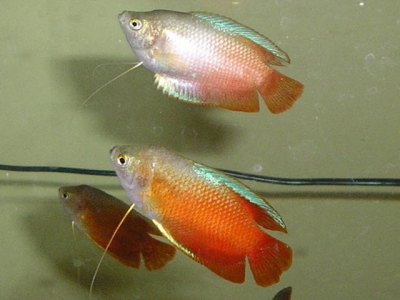Infection with Infectious Spleen and Kidney Necrosis Virus (ISKNV)

ISKNV in dwarf gourami: dwarf gourami naturally infected with an ISKNV-like iridovirus (top fish) showing pale colouration compared with unaffected fish (bottom fish)
Signs of disease
Important: Animals with disease may show one or more of the signs below, but the pathogen may still be present in the absence of any signs.
Disease signs at the farm, tank or pond level are:
• mortality between 50% and 100%
• fish remaining on bottom of tank and not feeding well
• lethargy
• respiratory distress (rapid movement of opercula).
Gross pathological signs are:
• changes in body colour (e.g. darkening or lightening of body colour)
• exophthalmos (popeye)
• abdominal distension (due to fluid or enlargement of organs).
Microscopic pathological signs are:
• basophilic hypertrophied cells throughout numerous body tissues, but especially the haematopoietic tissues of the kidney and spleen.
Disease agent
ISKNV-like viruses are a group of viral agents in the genus Megalocytivirus, family Iridoviridae. These viruses predominantly cause disease in freshwater fish (particularly cichlids, gouramis and poeciliids). The megalocytivirus agents included in this disease grouping are:
Cichlids:
• Angelfish iridovirus
• Cichlid iridovirus (includes ram cichlid and chromide cichlid)
• Iridovirus in Apistogramma spp.
• Iridovirus in oscars
• Iridovirus in rainbow krib
• Iridovirus in curviceps
Gouramis:
• Dwarf gourami iridovirus
• Pearl gourami iridovirus
• Iridovirus in thick-lipped gourami, three-spot gourami and silver gourami
• Iridovirus in paradise fish
Poeciliids:
• African lampeye iridovirus5
• Swordtail iridovirus6
• Iridovirus in mollies and platys
• Iridovirus in guppies.
Host range
Species known to be susceptible to ISKNV-like viruses are listed below. The list includes some native Australian fish species known to be highly susceptible to ISKNVlike viruses.
Presence in Australia
EXOTIC DISEASE—not present in Australia.
Epidemiology
• ISKNV-like viruses are prone to inactivation by desiccation or heat at temperatures above 50 °C, but are stable in water at 4 °C for extended periods.
• ISKNV-like viruses have been found to cause disease in a wide variety of species (i.e. may lack strict host specificity).
• Based on experimental transmission studies, horizontal transmission via cohabitation, water, ingestion of excreta or cannibalism is likely.
• There is evidence that some species may be long-term asymptomatic carriers of ISKNV-like viruses, and that prevalence in infected populations may be high.
Differential diagnosis
The list of similar diseases below refers only to the diseases covered by this field guide. Gross pathological signs may be representative of a number of diseases not included in this guide, which therefore should not be used to provide a definitive diagnosis, but rather as a tool to help identify the listed diseases that most closely account for the gross signs.
Similar diseases
Epizootic haematopoietic necrosis, grouper iridoviral disease, red sea bream iridoviral disease
Sample collection
Due to the uncertainty in differentiating diseases using only gross pathological signs, and because some aquatic animal disease agents might pose a risk to humans, only trained personnel should collect samples. You should phone your state or territory hotline number and report your observations if you are not appropriately trained. If samples have to be collected, the agency taking your call will provide advice on the appropriate course of action. Local or district fisheries or veterinary authorities may also provide advice regarding sampling.
Emergency disease hotline
The national disease hotline number is 1800 675 888. This number will put you in contact with the appropriate state or territory agency.
Further reading
Biosecurity Australia 2010, Importation of freshwater ornamental fish: review of biosecurity risks associated with gourami iridovirus and related viruses—provisional final import risk analysis report, Biosecurity Australia, Canberra.
Related news
 Fusarium mycotoxins continue to be the main threat to Southeast Asian aquaculture
Fusarium mycotoxins continue to be the main threat to Southeast Asian aquaculture In the recent issue of the World Mycotoxin Journal, Biomin experts, led by Rui A Gonçalves, reveal the most recent conclusions of their survey study on plant
 Probiotics to boost immune fitness and gut health
Probiotics to boost immune fitness and gut health Despite growing trends in probiotic use, their application in aquafeeds has been constrained by the aggressive feed manufacture process,
 Aquaculture in action: in-pond innovation doubles tilapia production in Egyptian trials
Aquaculture in action: in-pond innovation doubles tilapia production in Egyptian trials In the face of rising production costs and limited land and water availability, Egyptian fish farmers are looking for new ways to achieve higher productivity